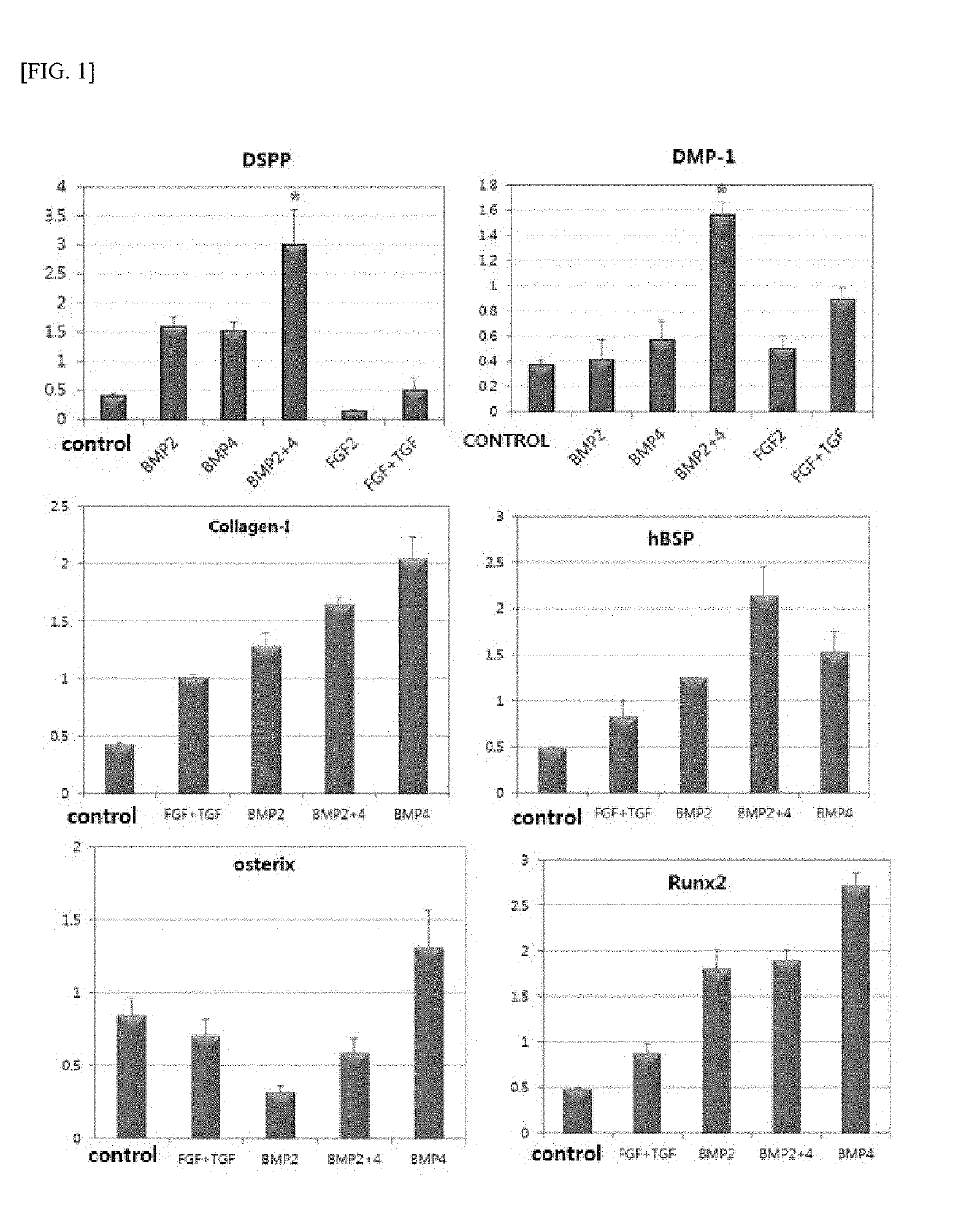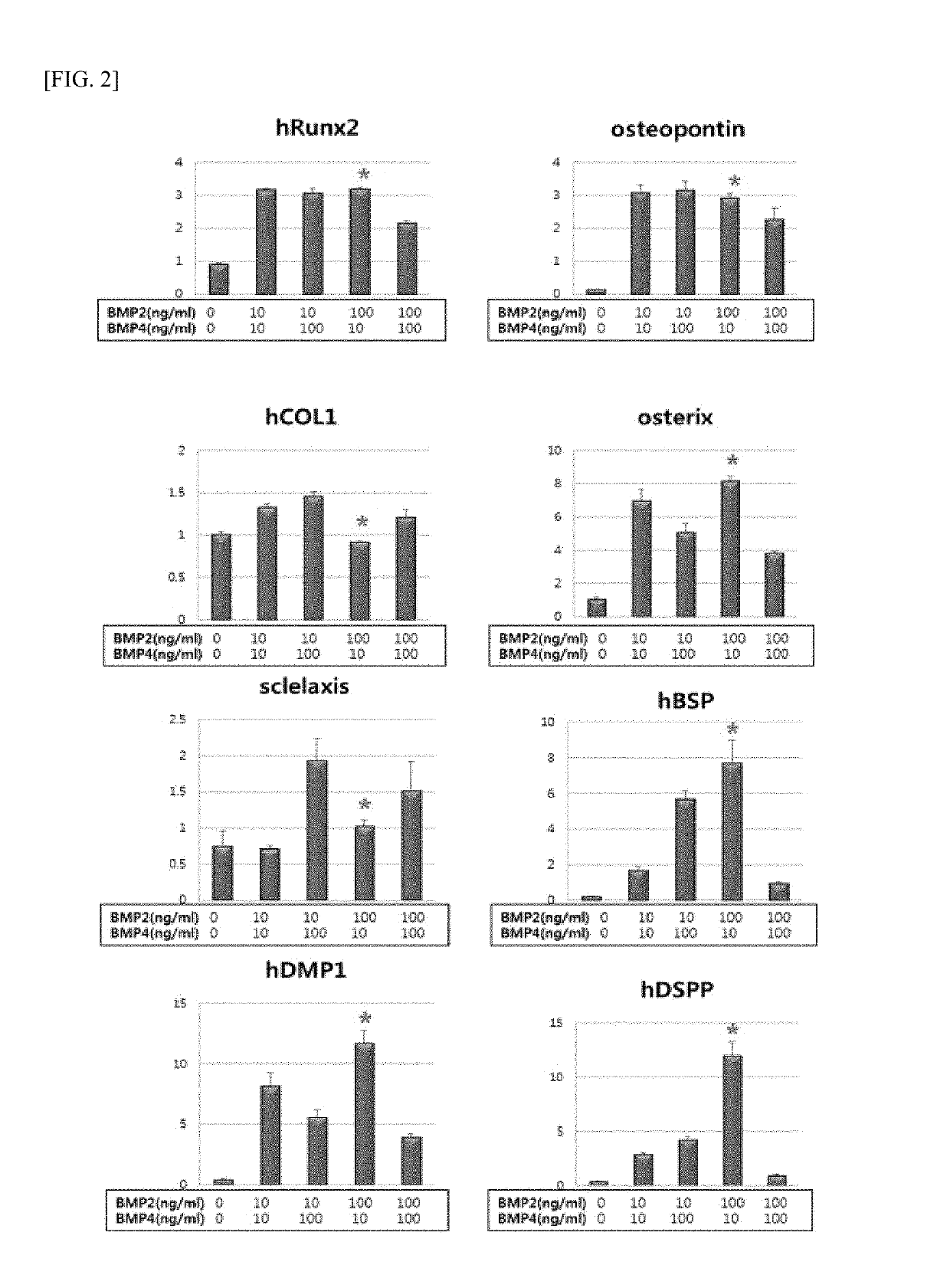IgG TYPE MONOCLONAL ANTIBODIES SPECIFICALLY BINDING TO ODONTOBLAST SURFACE
a monoclonal antibody and odontoblast technology, applied in the field of igg or igm type monoclonal antibody, can solve the problems of odontoblast isolation and purification, main differentiation factors and efficient differentiation conditions have not yet been established, and it is difficult to regenerate, etc., to improve the differentiation ability of odontoblasts, improve the differentiation efficiency of dental pulp stem cells, and restore the damage of dental pulp and dentin.
- Summary
- Abstract
- Description
- Claims
- Application Information
AI Technical Summary
Benefits of technology
Problems solved by technology
Method used
Image
Examples
example 1
ation of Gene Expression by Treatment Human Dental Pulp Stem Cells (hDPSCs) with Cytokine
[0186]To identify the conditions for differentiation of human dental pulp stem cells into odontoblasts, human dental pulp stem cells were treated with cytokines such as bone morphogenetic protein 2 (BMP2), bone morphogenetic protein 4 (BMP4), fibroblast growth factor 2 (FGF2), transforming growth factor β (TGFβ), or a combination thereof. The types and amounts of cytokines treated in this Example are shown in Table 1 below.
TABLE 1BMP2 +FGF +ControlBMP2BMP4BMP4FGF2TGFβTGFβng / ml0100100100 + 10050550 + 5
[0187]As shown in Table 1, After treatment with a cytokine, qRT-PCR was performed to identify whether genes expressing odontoblasts were expressed.
[0188]The sequences of target genes and primers identified in the qRT-PCR experiment are shown in Table 2 below. Among them, bone sialoprotein (BSP) is a gene expressed in differentiated osteoblasts, odontoblasts, and cementoblasts. Runt-related transcrip...
example 2
tion of Optimal Condition for BMP2 and BMP4 Combination for Differentiation into Odontoblast
[0192]The results of Example 1 confirmed that treating with BMP2 and BMP4 at the same time was efficient in order to differentiate human-derived dental pulp stem cells into odontoblasts. Further, in order to establish the optimal combination conditions of BMP2 and BMP4, human dental pulp stem cells were treated with various concentrations of BMP2 and BMP4 combinations as described in Table 3 below.
TABLE 3BMP2(ng / ml)01010100100BMP4(ng / ml)01010010100
[0193]After the treatment, the expression of the genes in dental pulp stem cells, which were described in Table 2, was confirmed by qRT-PCR, and the results are illustrated in FIG. 2.
[0194]As illustrated in FIG. 2, it was confirmed that the expression of Runx2, osteopontin, BSP, DMP1, and DSPP genes, which are odontoblast-related genes except for ligament progenitor markers such as hCOL1 and scleraxis genes, were significantly increased when treated...
example 3
ation of Differentiation Efficiency Under Optimal Condition for Differentiation into Odontoblast
[0198]The mineralization and bone differentiation degree thereof was measured to determine how high differentiation efficiency of the differentiated odontoblast was in the condition of the weight ratio of 10:1, which is the optimal combination ratio as confirmed in Example 2 above.
[0199]Specifically, the morphology of the cells was observed for 7 days in which dental pulp stem cells were treated with BMP2 and BMP4 at the same time as 10:1 and then differentiated into odontoblasts. The results are illustrated in FIG. 4.
[0200]As illustrated in FIG. 4, it was confirmed that there was no significant difference in terms of morphology during the differentiation of dental pulp stem cells into odontoblasts.
[0201]Thereafter, the cells were treated with a differentiation-inducing agent for mineralization and stood for 14 days. After the treatment, the cells were stained with Alizarin-red S (ARS) to...
PUM
| Property | Measurement | Unit |
|---|---|---|
| Volume | aaaaa | aaaaa |
| Length | aaaaa | aaaaa |
Abstract
Description
Claims
Application Information
 Login to View More
Login to View More - Generate Ideas
- Intellectual Property
- Life Sciences
- Materials
- Tech Scout
- Unparalleled Data Quality
- Higher Quality Content
- 60% Fewer Hallucinations
Browse by: Latest US Patents, China's latest patents, Technical Efficacy Thesaurus, Application Domain, Technology Topic, Popular Technical Reports.
© 2025 PatSnap. All rights reserved.Legal|Privacy policy|Modern Slavery Act Transparency Statement|Sitemap|About US| Contact US: help@patsnap.com



